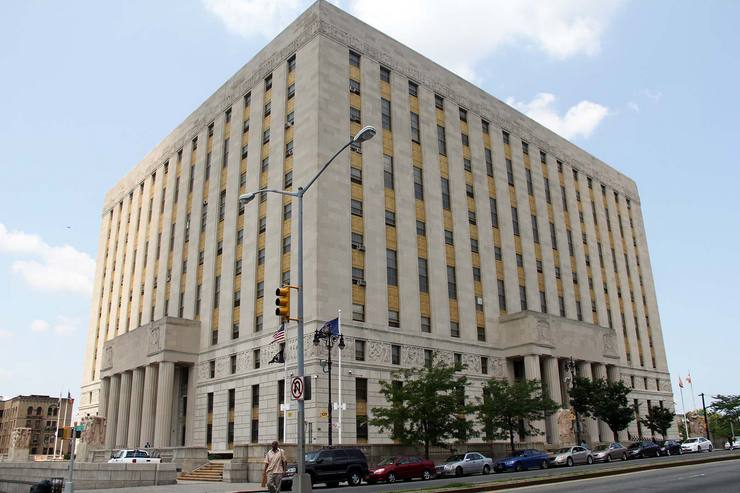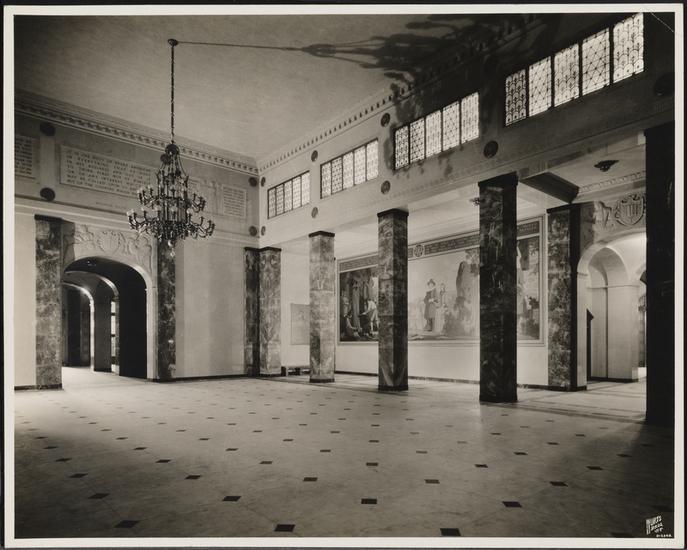
Built in 1933 during the Depression at a cost of $8 million, this public project provided sorely needed jobs for the architects, sculptors and various construction workers responsible for its creation. After the site was chosen in 1928, construction began in 1931 and took three and a half years to complete. In 1934, Mayor LaGuardia received a bronze key during the building's three-day dedication and celebration.

The most likely source of funding in 1931-32 was the New York State Temporary Emergency Relief Administration (TERA)[2,3,4], established by Governor Franklin D. Roosevelt on October 31, 1931, with Harry Hopkins as director, and later its president. Hopkins would go to lead the Federal Emergency Relief Administration (FERA) and the Works Progress Administration (WPA) during the Roosevelt presidency. I would argue that Roosevelt's New Deal began in New York State with TERA in 1931, and then when he became President, he expanded it to the nation as a whole. But regardless, a November 1933 New York Times article[9] indicates a large sum of money flowing from the federal Civil Works Administration into New York City and State work-relief agencies, which were the ones paying the workers on the courthouse project. This is a fairly solid indication of federal New Deal funding for at least the last half-year of construction (it opened June 15, 1934).
Architects: Max Hausle, Joseph H. Freedlander. Later Freedlander designed the Bronx House of Detention, a WPA project. Sculptors: Charles Keck, Adolf A. Weinman, Edward Field Sanford, George Holburn Snowden, Joseph Kiselewski. Muralist: James Monroe Hewlett. Keck's friezes are identified as WPA[10], the rest of the art was financed however the building itself was financed, "New York State New Deal", with or without federal assistance, who knows.
References:
- Mario Merola Building / Bronx County Courthouse, NYC Citywide Administrative Services website at nyc.gov.
- June Hopkins, Ph.D., The New York State Temporary Emergency Relief Administration: October 1, 1931, The Social Welfare History Project (undated).
- Publications of the New York State Temporary Relief Administration, 1931-1937, Volume 1 (628pp) and Volume 2 (634pp), NY TERA (1937), at Archive.org, the Internet Archive. Does not list specific projects, but notes in several places that it paid for the construction of court houses.
- Five Million People, One Billion Dollars: Final Report of the the Temporary Emergency Relief Administration, November 1, 1931—June 30, 1937. Mainly employment trends, statistics, and budgets; does not mention specific projects. However it notes that during a “typical period” (April 1935), 55.6% of work-relief man hours was spent on construction and improvement of public properties.
- 161st Street/River Avenue Rezoning - Overview, New York City Department of City Planning (2009); Context and History, p.3: "In 1933, New Deal public funds allowed the construction of the Bronx County Courthouse at the Grand Concourse and 161st Street."
- Ultan, Lloyd, and Shelley Olson, The Bronx: The Ultimate Guide to New York City's Beautiful Borough, Rutgers University Press (2015), pp.44-48 (for details about the architecture, statuary, friezes, etc). The authors also note that the courthouse was paid for entirely by state and city (not federal) funds, but without giving any details. TERA was precisely the state agency that would have dispensed these funds, given that they were used to provide "sorely needed jobs". Also see [9] about bow TERA (at least starting in 1933) was funded. On pp.45-47: "The massive carved high-relief blocks flanking each of the staircases ... bear allegoral scultpure[s] related to each inscription. These massive blocks were carved by noted sculptor Adolph Weinman assisted by Edward F. Sanford, George Snowden, and Joseph Kisselewski." This continues for a page and half, describing each sculpture group: Spirit of Progress, Civic Fame, Majesty of the Law, Civic Government, and so on, eight in all.
- Bronx County Courthouse, LPC 1976/07/13 #2 LP-0928, NYC Landmarks Preservation Commission. Detailed history including descriptions of the architecture and art, but no mention of funding sources for the building or the art, except to say "During the depression of the 1930s government-funded projects such as this courthouse provided architects and artists with welcome large-scale commissions."
- New York - Bronx County, National Register of Historic Places, listing of registered historic places in the Bronx, including the courthouse (Registry Number 83001636): "The PDF file for this National Register record has not yet been digitized."
- 90,000 Jobs Here in Work Program - All on Federal Payroll, New York Times, 23 November 1933, p.15. Doesn't mention any specific projects but explains that "under the Federal civil works program" (i.e. CWA) federal money will be funneled through the City Emergency Work Administration and various other City and State relief agencies
- Facts about Charles Keck, askART.com (accessed 14 May 2021): "Keck created the frieze on the facade of the Bronx County Building in New York in 1933 under the auspices of the Depression-era Works Progress Administration (WPA)." [This is not strictly true since WPA didn't start until 1935 but it could easily have been the some other agency such as the Public Works Art Project] "His subjects are classical, Biblical and symbolic, including the West Facade frieze depiction of the Civil War surrender of General Lee to General Grant with Revolutionary pipers in uniform; images of a young, growing and working America; as well as an allusion to slavery."
- Bronx County Building Hightlights, Borough President Rubén Díaz Jr.: Gallery of the four James Monroe Hewlett murals from the entrance hall.
- In a courthouse, works of Bronx art, AM New York (2018). More about the murals.
- Barbaralee Diamonstein-Spielvogel, The Landmarks of New York, Washington Mews Books, Sixth Edition (2016), p.716. The courthouse was built between 1931 and 1934, so partially while FDR was New York Governer and partially while he was President: "The Bronx County Courthouse is a handsome example of government funded civic architecture during the New Deal ... A frieze by Charles Keck[10] celebrates the activities of the universal working man. Flanking each entry are two monumental freestanding figural groups, carved in pink marble, by Adolf A. Weinman[14]."
- The Bronx County Court Building, Lehman College Art Gallery (accessed 14 May 2021): "Adolph A. Weinman with collaboration by George Snowden, Joseph Kiselewski, Max Hausle, Joseph Friedlander, Edward Field Sanford Jr. Eight Statuary Groups 1932, marble, each 100" x 121" x 70", entryway sculptures, WPA. The Bronx County Building is an enormous limestone structure in the Art Moderne style. It was built in 1933 by the architects Joseph Freedlander and Max Hausle in collaboration with the artists Adolph A. Weinman (1870-1952) who designed the rectangular block sculptures at the entrances to the building, and Charles Keck (1875-1951) who designed the friezes. The Art Deco design of the building reflects the architecture of many of the buildings along the Grand Concourse. The project was sponsored by the Works Progress Administration."
- Antonio Pacheco, When Government Came to Main Street, Urban Omnibus, Architectural League of New York, 3 November 2021: "The design and construction of the building took place amid a backdrop of political reforms under the leadership of Franklin Delano Roosevelt. First as Governor of New York State, and later as President of the United States, Roosevelt undertook a vigorous effort to modernize government by stamping out a culture of ingrained political corruption ... in 1931, Governor Roosevelt created the Temporary Emergency Relief Administration (TERA), a program for urgent unemployment assistance that also pushed a reconsideration of New York State's role in the welfare of its citizens. Rather than simply putting impoverished people on 'the dole,' as Hoover had feared, TERA put New York residents to work, providing them wages in return for their labor. The legislation also cemented critical labor reforms, including the establishment of a five-day workweek for public works projects, the prohibition of "discrimination on account of race, color, non-citizenship, or political connections," and the provision of workmen's compensation insurance for relief workers. Ultimately, some of the spirit of creative legislative reform established by TERA was taken up by later New Deal programs, including the Federal Emergency Relief Administration (FERA), Civil Works Administration (CWA), Public Works Administration (PWA), and Works Progress Administration (WPA). Several of these programs funded the completion of the courthouse, which was still under construction when Roosevelt left the Governor's office for the White House in 1932." Includes 20 original images, most of them of the exterior and interior of the building.
|
The New Deal in
NYC 1932-1943 |
Frank da Cruz |
fdc@columbia.edu
|